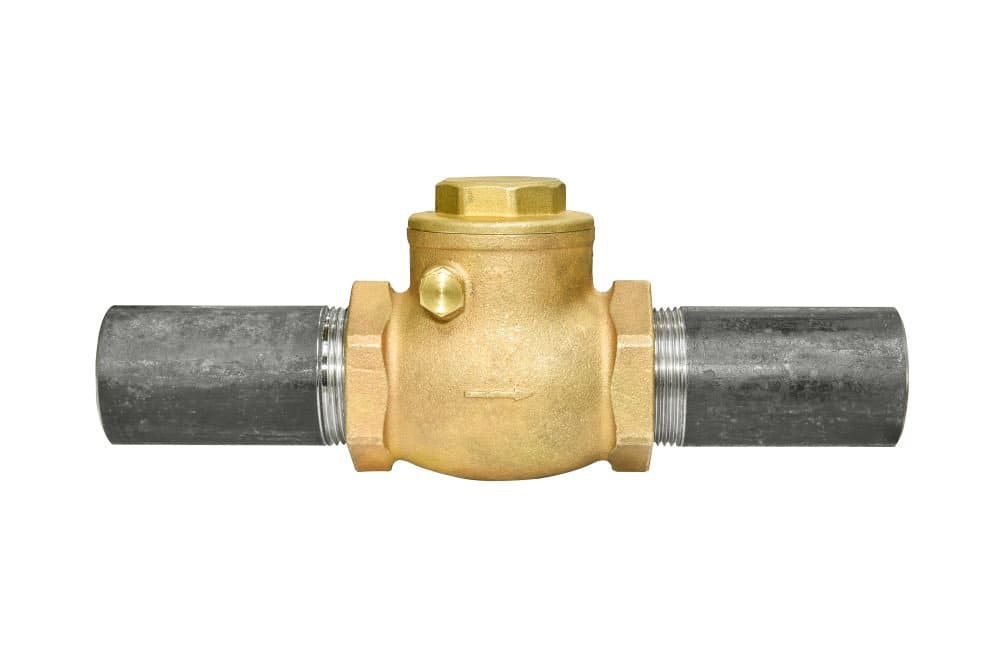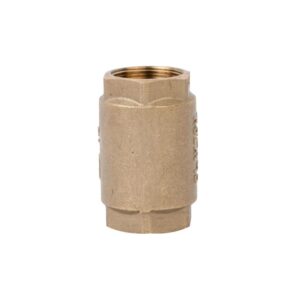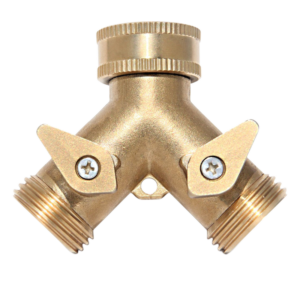Description
Brass Swing Check Valve
JX-0602
- Nominal Pressure: 1.6MPa
- Working Medium: Water, Non-corrosive liquid
- Working Temperature: -20℃≤t≤150℃
- Thread to ISO228
- Note: Sealing Material is Brass
- Swing check valve size: 1-1/4 inch BSP female x female threaded.
- Swing check valve material: Brass.
- Max pressure: 200 Psi.
- Wide application: Applicable for water, steam, oils, nitric acid, urea, and more. They are mainly used in petroleum, chemical, pharmacy, fertilizer, and electricity pipelines.
- Good sealing: The lifting and closing parts are opened or closed by the medium flow and the force, and the sealing property is suitable to prevent liquid leakage. This type of valve should be installed horizontally, allowing only the medium to flow in one direction to avoid accidents.

Swing Check Valves are used for water and other liquids. Swing Check Valves can be installed in horizontal or vertical upward flow pipe systems. The valve should have a rubber-faced seal for low-pressure applications and air or gas systems where bubble-tight closure is necessary. The current range does not include this facility, but a feature can be available for special orders. Applications and uses Check Valve range are available with water, oil, and air up to 20 bar.
A brass swing check valve, also known as a ballcock, is essential for plumbing systems. It is used to prevent the backflow of water and the buildup of pressure in the system. A brass swing check valve can leak or burst if installed correctly or maintained regularly.

-A brass swing check valve is available in many different sizes. Be sure to choose the right size for your system!
-The valves are also available in either threaded or flanged ends. Choose the type that will fit best with your plumbing system.
-A brass swing check valve should be installed so that water flow always goes in the same direction. This will help to prevent leaks and bursts.
-If you notice that your brass swing check valve is leaking, it may need to be repaired or replaced. Contact a professional plumber if you have any questions or concerns.
-Be sure to have a backup plan in case of a valve failure. This could include a pump or other device to help move water through the system.
Swing Check Valve
Swing check valves are important to various industries’ plumbing and engineering systems. Their primary purpose is to prevent the reverse flow of liquid or gas within a pipe system. This type of valve is designed with a disc that swings freely on its hinge, allowing fluid to flow through it in one direction. When the pressure within the system changes, the disc will swing shut to stop any backflow from occurring.
These valves are known for their durability, making them suitable for indoor and outdoor applications. Depending on the system design requirements, they can be installed horizontally or vertically and have excellent resistance against wear and tear. They also require little maintenance, making them an ideal choice for critical operations where downtime is not an option. Swing check valves are available in various sizes and can handle multiple pressures to suit almost any application requirement.
Functionality: Closes Automatically
A Swing Check Valve is a type of mechanical device that is used to ensure the flow of liquid through pipes in a single direction. This type of valve typically consists of a hinged disc and a cylindrical body, which opens when pressure from upstream pushes the disc up against its seat, allowing it to swing away from the pipe’s surface. The unique feature of this valve is that it can also close automatically without any manual intervention.
This makes it an ideal choice for regulating fluid flow in pipelines where frequent opening and closing are not required. It provides reliable protection against backflow due to gravity or pressure differences at different points in the system, thereby helping to prevent damage caused by improper flow reversal or water hammering. These valves are relatively easy to install and require minimal maintenance thanks to their self-closing action.
Types of Swing Check Valves
Swing check valves are a type of valve used to control the flow of liquid or gas through a system. Selecting the correct type of swing check valve for your particular application is essential to ensure it can handle the pressure and fluids in your pipelines. Many swing check valves are available, each with advantages and disadvantages.
The two most common types of swing check valves are lift-type and ball-type. Lift-type swing check valves feature a disc that opens when pressure within the system is higher on one side than another, allowing fluid or gas to pass through. Ball-type swing check valves contain a ball bearing that pivots when pressure changes occur in either direction, obstructing flow until enough pressure is built up on one side for the ball bearing to pivot, allowing fluid or gas flow in either direction.
Installation Overview
Swing check valves are commonly used in plumbing systems to prevent the reversal of flow, and they have become increasingly popular in recent years. The installation process for a swing check valve is pretty straightforward; however, professional plumbers may be required if any adjustments or repairs are needed. This article provides an overview of the steps involved in installing a swing check valve.
First, ensure all necessary tools and materials are readily available before installation. Once you have everything on hand, turn off the water supply to avoid any accidents during installation. Then locate the spot where you want to install the valve, ensuring it is at least six inches below any pipe fittings upstream from it and positioned so that its arrow points towards downstream pipes.
Advantages & Disadvantages
Swing check valves are an important component of many plumbing systems, as they help regulate water flow and protect pipes from becoming over-pressurized. But, it is equally important for users to be aware of both the advantages and disadvantages of swing check valves to make an informed decision about whether or not this type of valve suits their system. A primary benefit of swing check valves is that they are relatively easy to install and maintain due to their simple design. Additionally, they offer superior protection against reverse water flow compared to other valves, making them an excellent choice for applications where backflow needs extra attention. On the other hand, drawbacks include their tendency to become damaged more easily than ball or gate valves when used with abrasive media such as sand or gravel.
Maintenance Tips
Regular maintenance is key to keeping your swing check valve in top condition. This type of valve controls the flow of liquids and gases and is essential for safety and proper operation in various systems. Here are some tips on how to properly maintain your swing check valve:
First, inspect the seat. Make sure that no scratches or defects could affect its performance over time. Also, examine the poppet for any signs of wear or corrosion. If you notice anything unusual, consider replacing it with a new one.
Second, make sure that all fasteners and screws are securely tightened; this will prevent potential leaks from developing due to vibration or pressure changes within the system.








